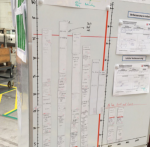Yamazumi! Yes, yamazumi…
I remember one of my senseis asking me one day: can you do one hour of 100% value-added every day?
As I write this, I think: “what is going to make this piece interesting?” (that’s a hit and miss) I also think: “can I get it done in an hour?” (Often do).
What is 100% value-added when you’re a writer? First, it’s writing a piece that will trigger some realization, some “aha!” moment in a reader. The piece has to grab the reader’s attention, then it has to make a point – a surprising-but-completely-inescapable point if possible – then, it should be cheerful and have some element of fun, as well as being fluid and easy to read (chase these passive verbes…). It also should be truthful, precise and not misleading.
Besides, it has to be written straight up, without endless rewrites and corrections. This second part is no easier than the first, because in writing, sometimes re-writing is the only way to clarify your own thinking and formulate new ideas. Writers also can switch to automatic pilot and write badly without quite meaning to do so, which needs to be caught at re-read and fixed.
Every day, we do the things we do. We get a job done, it takes the time it takes, it comes out the way it does, we correct the glaring issues when we spot them or when the next person in the line complains about it.
We have personal routines to get the job done habitually and without too much mental effort. We then have rituals to do stuff in a certain order with others. Routines and rituals get us through most of the day – straight into irrelevancy.
When people look into lean (which, to my mind, is the sum of attempts of transferring the Toyota Production System out of Toyota), they often miss the fact that the engineers who came up with this improvement system were the same guys who learned to build cars from scratch in the 1930s, and factories out of paddy fields in the 1950s. They knew the product and the process inside out.
They realized they could never have the volume to compete with US automakers, so they thought of something different: quality and flexibility through kaizen.
Quality is not simply about not making a bad job, but constantly challenging what a good job should be – what, in what we do, actually helps the customer? What is waste (necessary, maybe, but still waste)?
Flexibility is the ability to switch from making one good job, to making another good job. After writing this piece I have to seamlessly switch to going to the gemba. And it all has to fit within one day.
In the end, it’s all about studying the work content of the job. How many tasks in the day? At what rhythm (takt time)? and for each one:
- What is it that makes it a good job (100% value-added)?
- How long should the task normally take?
- What are the points often needing rework?
- What is an opportunity for kaizen?
Which can be visualized in a yamazumi chart: a task stack up chart.

Or, in the case of writing this piece:
- Thinking about the point to make – how long?
- The tool to discuss – how long?
- Come up with an attention grabber – how long?
- Sketch an outline – how long?
- Write – how long?
- Print and read – how long?
- Correct – how long?
- Publish – how long?
As you can see from this example, actually making the yamazumi chart is very demanding and makes you ask rather hard questions. We’d much prefer just getting the job done and get on with it.
The lean tools are really about forcing oneself to take a closer look at what one does, find problems and turn them in opportunities to improve. And in the end, it’s all about the actual content of the work, not the work itself.
Mastery doesn’t come out of mindless repetition. It comes out of constantly striving to do it better. As Jeff Bezos told the Washington Post reporters: “When you’re writing, be riveting, be right and ask people to pay. They will pay.”
Being riveting and right doesn’t come naturally (neither does asking people to pay – I certainly don’t have the nerve). You work at it by looking at what you do, challenging it and thinking about how to do it better. Then try something new. The lean tools give us many way to look into our own work. Routines and rituals are there to be challenged, else they become meaningless and boring.
In the end, it’s all about work content and answering the question of what would 100% value added really look like?









